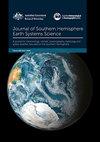Effects of heat extremes on wheat yields in Australia
IF 3.6
4区 地球科学
Q1 Earth and Planetary Sciences
引用次数: 0
Abstract
Many agricultural studies have identified that wheat yield is sensitive to seasonal rainfall and extreme high temperatures. We investigate the impact of extreme heat events, in particular on wheat yields in South-East Australia (SEA) and South-West Western Australia (SWWA).We define a 'heat-day' as a day where the daily maximum temperature exceeds the 1911–2013 90th percentile for the respective calendar month. We find that the number of heat-days has experienced statistically significant increases across most months across much of Australia, particularly in South Australia, Western Australia, the Northern Territory and Tasmania. The trends are especially marked in winter, including in key wheat-growing regions. The temperatures recorded on these hottest days have also shown a statistically significant increase over the last 100 years.We find that, while wheat yields are more strongly correlated with rainfall than with the number of heat-days, there is substantial evidence to suggest that during drought conditions wheat yields are sensitive to the number of heat-days recorded in August and September in SEA and September and October in SWWA. Extreme heat and rainfall have a stronger association with below-average yields than above-average yields.Extreme temperatures and rainfall in these regions are related to major Australian climate drivers which form the basis of seasonal prediction models and are important for natural variability and long-term climate change. Here we assess the degree to which wheat yields in both regions can be related to the El Niño Southern Oscillation (ENSO), Indian Ocean Dipole (IOD) and Southern Annular Mode (SAM). We find that positive IOD events and El Niño events are both associated with reductions in wheat yields in SEA, but that the co-incidence of these events have no additional wheat yield reductions than would be expected if either a positive IOD or El Niño event occurs. The average annual wheat yield loss associated with El Niño state and/or positive IOD state in SEA is estimated to around sixteen to twenty one per cent.This paper provides insights into the historical relationships between wheat yields, extreme heat and climatic modes of variability in Australia, and discusses the possibilities for changes in wheat yields under a future climate change scenario.极端高温对澳大利亚小麦产量的影响
许多农业研究表明,小麦产量对季节性降雨和极端高温非常敏感。我们调查了极端高温事件的影响,特别是对东南澳大利亚(SEA)和西南西澳大利亚(SWWA)的小麦产量。我们定义了一个热日'日最高气温超过1911-2013年相应历月的第90个百分位数的日子。我们发现,在澳大利亚大部分地区,特别是在南澳大利亚、西澳大利亚、北领地和塔斯马尼亚州,大多数月份的高温天数在统计上都有显著增加。这种趋势在冬季尤其明显,包括在主要的小麦种植区。在过去的100年里,在这些最热的日子里记录的温度在统计上也有显著的增加。研究发现,虽然小麦产量与降雨量的相关性比与高温日数的相关性更强,但有大量证据表明,在干旱条件下,小麦产量对东南亚8月和9月以及西南西南地区9月和10月的高温日数敏感。极端高温和降雨与低于平均产量的关系比与高于平均产量的关系更强。这些地区的极端温度和降雨与澳大利亚的主要气候驱动因素有关,这些驱动因素构成了季节性预测模式的基础,对自然变率和长期气候变化很重要。在这里,我们评估了这两个地区的小麦产量与厄尔Niño南方涛动(ENSO)、印度洋偶极子(IOD)和南环模(SAM)的关系程度。我们发现,正IOD事件和El Niño事件都与东南亚地区小麦产量的减少有关,但如果发生正IOD事件或El Niño事件,这些事件的共同发生率不会造成额外的小麦产量减少。与El Niño状态和/或东南亚正IOD状态相关的小麦年平均产量损失估计约为16%至21%。本文提供了对澳大利亚小麦产量、极端高温和气候变化模式之间的历史关系的见解,并讨论了未来气候变化情景下小麦产量变化的可能性。
本文章由计算机程序翻译,如有差异,请以英文原文为准。
求助全文
约1分钟内获得全文
求助全文
来源期刊

Journal of Southern Hemisphere Earth Systems Science
Earth and Planetary Sciences-Oceanography
CiteScore
8.10
自引率
8.30%
发文量
0
审稿时长
>12 weeks
期刊介绍:
The Journal of Southern Hemisphere Earth Systems Science (JSHESS) publishes broad areas of research with a distinct emphasis on the Southern Hemisphere. The scope of the Journal encompasses the study of the mean state, variability and change of the atmosphere, oceans, and land surface, including the cryosphere, from hemispheric to regional scales.
general circulation of the atmosphere and oceans,
climate change and variability ,
climate impacts,
climate modelling ,
past change in the climate system including palaeoclimate variability,
atmospheric dynamics,
synoptic meteorology,
mesoscale meteorology and severe weather,
tropical meteorology,
observation systems,
remote sensing of atmospheric, oceanic and land surface processes,
weather, climate and ocean prediction,
atmospheric and oceanic composition and chemistry,
physical oceanography,
air‐sea interactions,
coastal zone processes,
hydrology,
cryosphere‐atmosphere interactions,
land surface‐atmosphere interactions,
space weather, including impacts and mitigation on technology,
ionospheric, magnetospheric, auroral and space physics,
data assimilation applied to the above subject areas .
Authors are encouraged to contact the Editor for specific advice on whether the subject matter of a proposed submission is appropriate for the Journal of Southern Hemisphere Earth Systems Science.
 求助内容:
求助内容: 应助结果提醒方式:
应助结果提醒方式:


